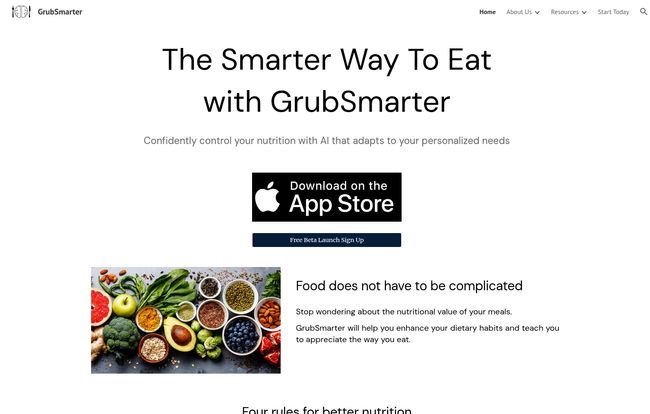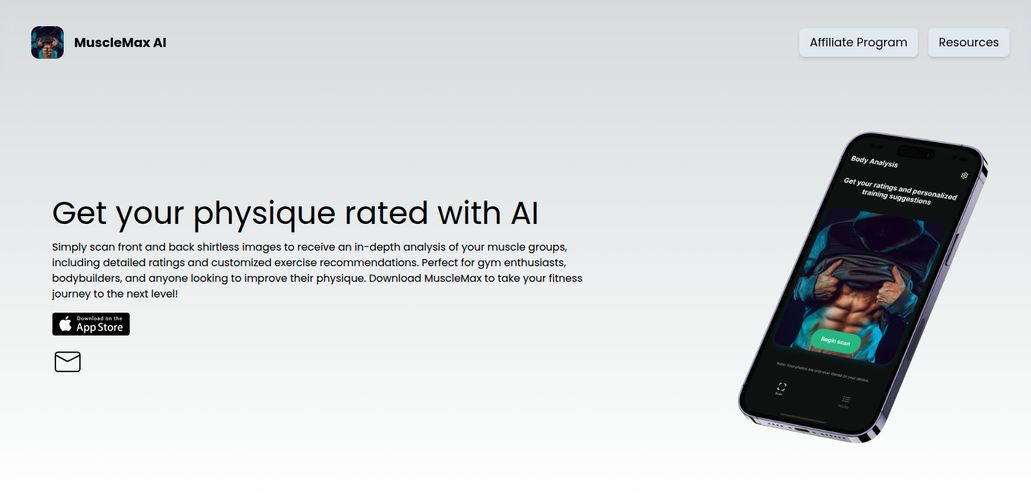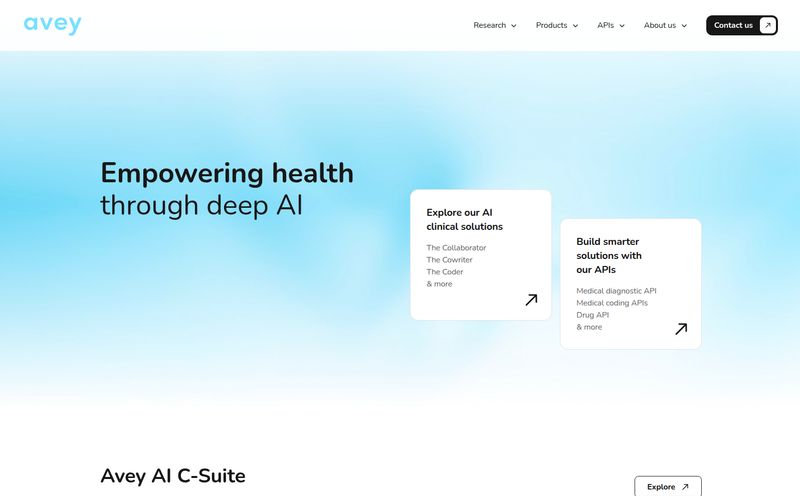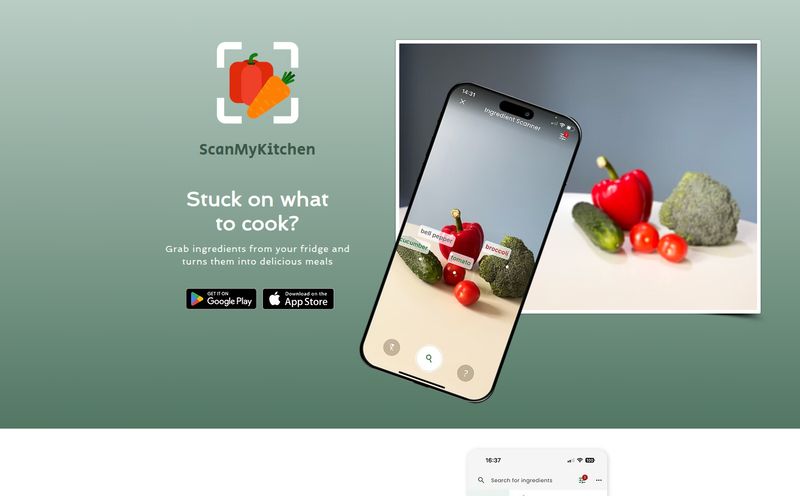Dieting kind of sucks. The endless counting, the 'good' food lists, the 'bad' food lists, the guilt after eating a piece of pizza... it’s exhausting. For years, the digital health world has tried to solve this with apps. We’ve all been there, dutifully logging every last almond into MyFitnessPal, only to burn out a few weeks later. It feels like a chore. A second job you don’t get paid for.
So when a new app called GrubSmarter pops up on my radar, claiming to be “The Smarter Way To Eat,” my inner skeptic raises an eyebrow. It’s waving the big, shiny “AI” flag, promising to control my nutrition with tech that adapts to my personal needs. It’s a bold claim. Is this just another calorie counter in a slick new outfit, or is there something more going on here?
I’ve spent my fair share of time in the trenches of traffic generation and trend analysis, and I've seen countless health apps come and go. Most of them are the same old thing repackaged. But GrubSmarter’s philosophy… it actually made me pause. So, I put on my critic’s hat and decided to see if this thing is legit.
So What Exactly Is GrubSmarter?
At its core, GrubSmarter is an AI-powered nutrition app for your phone. But hold on, don’t let the “AI” buzzword scare you off just yet. It's not about some robot overlord dictating that you must eat kale for every meal. From what I can gather, the platform is less about rigid rules and more about building awareness. It’s designed to be a guide, a sort of nutritional co-pilot that helps you understand your own habits rather than just shaming you for them.
Instead of just giving you a calorie budget, it aims to provide personalized guidance that adapts as you go. You eat, you log, you reflect. The AI is supposed to learn your patterns and help you make small, sustainable tweaks. It's a different angle, for sure. One that feels more like a coach and less like a prison warden.

Visit GrubSmarter
The GrubSmarter Philosophy: Its Four Rules for Better Nutrition
This is where things get interesting. GrubSmarter isn't just a tool; it's built on a specific mindset. Their homepage lays out four simple rules, and honestly, they're a breath of fresh air compared to the usual diet dogma. It’s the kind of stuff you hear from seasoned dietitians, not typically from a tech startup.
1. Learning from How You Feel, Not Just What You Ate
GrubSmarter introduces this idea of a “nutritional journal” where you assign a “bite role” to your meals. What did you want from that meal? Energy? Comfort? A social experience? This shifts the focus from pure numbers (calories, grams of fat) to mindfulness. It’s asking why you ate something, which is a question that can uncover a lot more about your habits than a simple calorie count ever could.
2. Actually Living Your Life (Yes, Even When Watching Your Diet)
Their second rule is to “color your calendar with life.” They openly encourage you to plan for dining out and special occasions. Hallelujah! So many nutrition plans fall apart the second a friend invites you out for birthday cake. By acknowledging that life happens, and that food is a huge part of it, GrubSmarter feels more grounded in reality. It’s not about avoiding life; it's about integrating it.
3. The Radical Idea That No Food is “Bad”
This might be my favorite part. GrubSmarter states, “All foods are created equal.” They argue that no food is inherently good or bad; they're just... food. Nutritionally different, yes, but not morally charged. The key, they say, is adaptation. This directly combats the toxic 'clean eating' culture that can lead to so much anxiety and guilt. A slice of chocolate cake isn't a failure; it’s just a set of nutritional data points your body will process. This mindset shift is, in my opinion, huge.
4. Embracing the Slow Burn of Change
Finally, the app encourages you to think about consistency. It poses a question: what would happen if your eating choices from today were repeated for a year? Would you be healthier? The point isn’t to be perfect today. The point is to build a pattern that, over time, leads you to a better place. It's about the long game, not a 30-day blitz.
A Quick Peek Inside the App
Based on the demos, the GrubSmarter app itself looks pretty clean and uncluttered. You have a main summary dashboard that shows your meals for the day. Pretty standard stuff. Then there are screens for analyzing a meal (where you log what you ate) and a meal history view. It doesn't seem bogged down with a million features, which I appreciate. The focus is clearly on the simple loop of: eat, log, reflect. It looks less like a complex data-entry spreadsheet and more like a simple, modern journal.
The Good, The Bad, and The AI
No tool is perfect, right? After digging in, here’s my breakdown of where I think GrubSmarter shines and where it might stumble.
What I Like About the GrubSmarter Approach
The biggest pro here is the emphasis on psychology and habits over pure restriction. It’s trying to fix the user's relationship with food, which is the root cause of so many issues. The personalized guidance and the focus on awareness are fantastic. It’s a simple, straightforward approach that could genuinely help people who feel trapped in the yo-yo diet cycle. I'm a big fan of the “no bad foods” mantra, its a healthier way to approach nutrition for the long term.
Potential Sticking Points to Consider
First, like any tracking app, it requires consistency. If you don't log your meals, the AI has nothing to work with. This is the hurdle where most people fall, and GrubSmarter is no different. Second, the reliance on AI might not be for everyone. Some of us are data nerds who want to see our exact macro split. GrubSmarter seems to obscure some of that in favor of a more holistic view. Lastly, they're a bit quiet about their AI. What algorithms is it using? Is it true machine learning or a series of clever if/then statements? For the average user, this doesn't matter, but for the tech-curious, it's a bit of a black box.
What's the Price Tag? The Big Question Mark
Here’s the rub. I went looking for pricing information, and… nothing. The website is currently promoting a “Free Beta Launch Sign Up,” which tells me the app is brand new and still in its testing phase. When I tried to find a potential pricing page, I hit a 404 error. So, for now, it seems you can sign up to test it for free. I'd wager they’ll move to a subscription model down the line, similar to competitors like Noom or Lifesum. My guess? Somewhere in the $15-20/month range once it officially launches.
So, Who Is GrubSmarter Actually For?
In my professional opinion, GrubSmarter is not for the hardcore bodybuilder or elite athlete who needs to track every microgram of their intake. It’s for the everyday person. It’s for you if you're tired of feeling guilty about food, if you’ve tried and failed with other calorie counters, and if you want to build a healthier, more intuitive way of eating without feeling like you’re in diet jail. If you’re looking to change your habits for the long haul, this seems like a really promising start.
Frequently Asked Questions about GrubSmarter
- Is GrubSmarter just another calorie counter?
- Not exactly. While it does involve tracking your food, its main focus is on helping you understand your eating habits, how food makes you feel, and changing your mindset around nutrition, rather than just hitting a calorie target.
- Do I have to track everything I eat on GrubSmarter?
- Yes, for the AI to work effectively, you need to be fairly consistent with logging your meals. The platform's ability to provide personalized guidance depends on the data you provide it.
- Is GrubSmarter free to use?
- Currently, GrubSmarter is in a beta phase, and you can sign up to test it for free. It is likely to become a paid subscription service after its official launch.
- How does the GrubSmarter AI actually work?
- The company hasn't released specific details on its AI algorithms. Generally, it learns from the meals you log and the context you provide (like the “bite role”) to identify patterns and offer adaptive suggestions over time.
- Can I use GrubSmarter for specific diets like keto or vegan?
- The platform's philosophy is about adaptation and not restricting food groups, so it might not be ideal for enforcing strict diet rules like keto. However, because you log what you eat, you could certainly use it to track your intake while following a vegan or vegetarian lifestyle.
- What makes GrubSmarter different from Noom or MyFitnessPal?
- MyFitnessPal is primarily a food and calorie database. Noom heavily incorporates psychology and human coaching. GrubSmarter seems to sit in between, using AI to deliver the psychological and adaptive coaching component, focusing on mindfulness and habit formation without the explicit human coach.
Final Thoughts on GrubSmarter
I see a lot of apps. A lot. And most of them are noise. GrubSmarter, however, feels different. It’s talking about the right things: consistency, mindfulness, and a healthy psychological approach to food. It’s not promising a six-pack in six weeks. It’s offering a tool to help you become more conscious of what you eat and why.
Will it work for everyone? Of course not. But for the millions of people who are just plain tired of the war against food, it might just be the smarter way. It’s a tool aimed at creating peace, not problems. And in the world of nutrition, that's a goal worth rooting for.
Reference and Sources
- GrubSmarter Official Website: www.grubsmarter.com
- Psychology Today: The Real Reason Why Most Diets Fail



